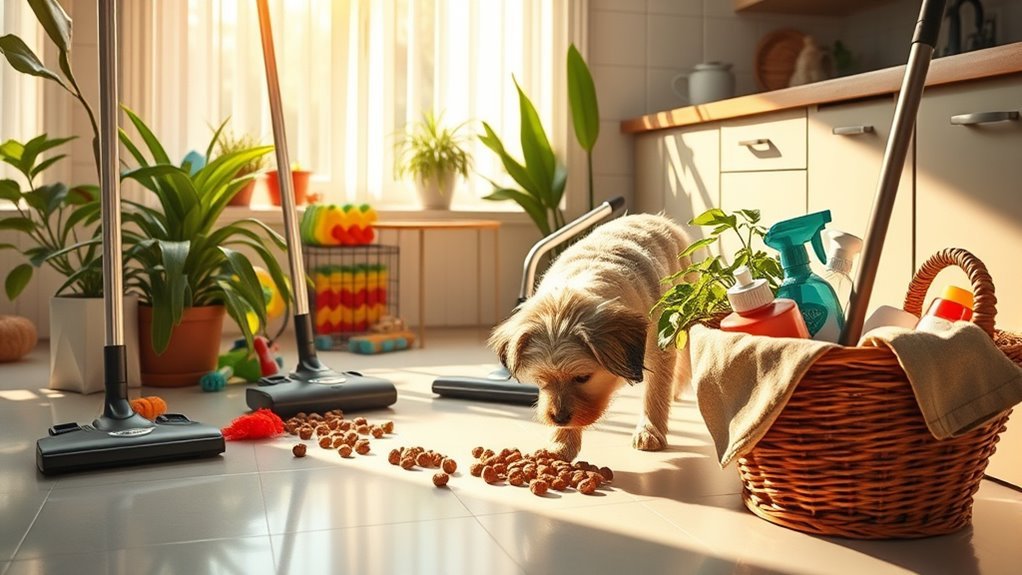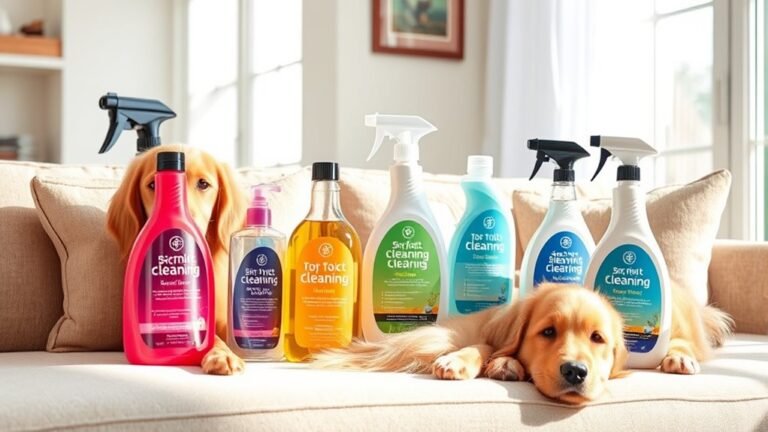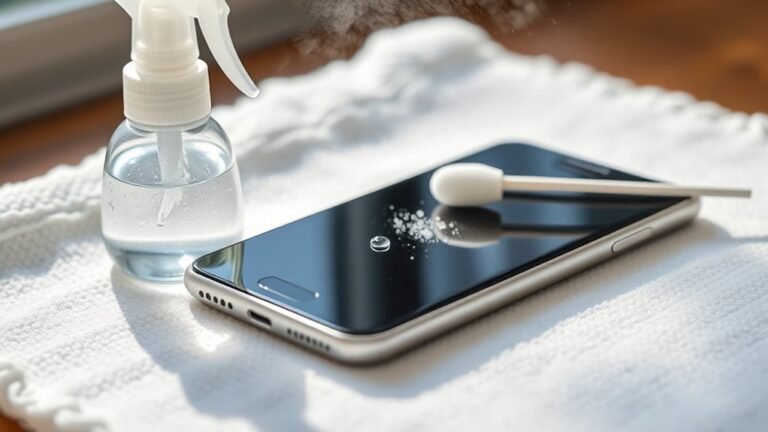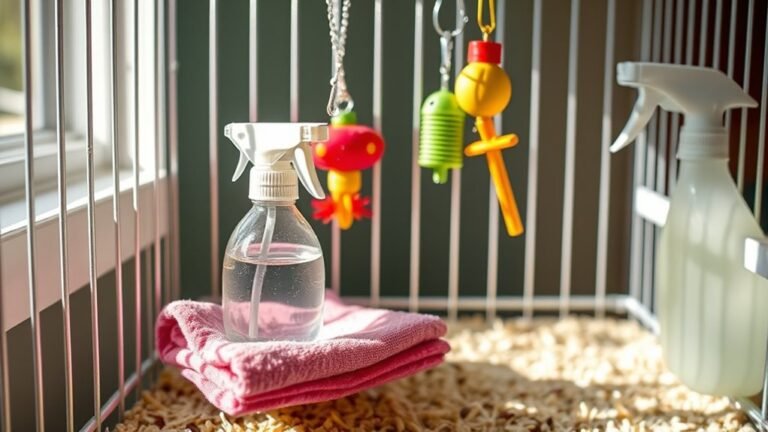Top 10 Tips for Cleaning Pet Mess
When cleaning pet messes, act quickly to blot, not rub, to prevent stains from setting. Use enzymatic cleaners to break down stains and odors effectively. Keep cleaning supplies handy for fast response, and sprinkle baking soda to neutralize odors. Wash pet bedding and toys regularly, clean litter boxes daily, and protect your furniture with washable covers. Training your pets to minimize messes helps maintain a cleaner home. With these tips, you’ll create a fresher, more comfortable space for you and your pets.
Act Quickly to Prevent Stains
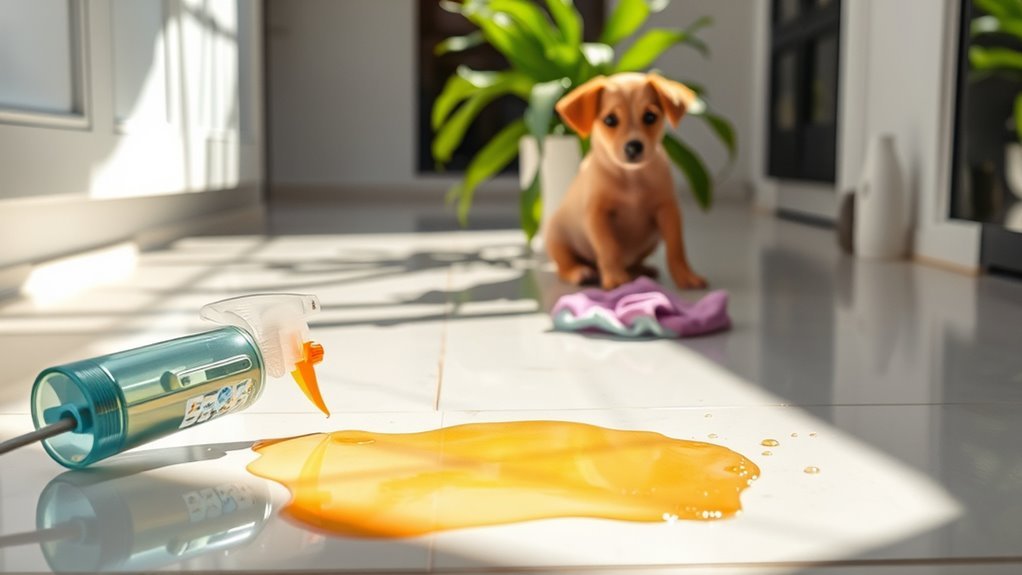
Although accidents happen, acting quickly when your pet makes a mess can considerably reduce the chance of stains setting in. You’ll want to prioritize pet mess prevention by responding immediately to spills or accidents. The key is an immediate response: blot the area gently with a clean cloth to absorb moisture without spreading it further. Avoid rubbing, which can embed stains deeper into fibers. Quickly removing excess mess helps prevent stubborn discoloration and lingering odors. Staying prepared with cleaning materials nearby supports your freedom to handle situations calmly and efficiently. By acting promptly, you maintain a clean environment while minimizing damage and stress. This proactive approach guarantees your living space stays fresh and welcoming, giving you more time to enjoy life with your furry companion. Using enzyme cleaners can also help break down tough stains and eliminate odors effectively.
Use Enzymatic Cleaners for Pet Stains
When you use enzymatic cleaners, they break down the proteins in pet stains and odors, making them easier to remove completely. To get the best results, apply the cleaner generously and let it sit for the recommended time to fully neutralize the mess. This approach helps prevent your pet from re-marking the same spot and keeps your home fresh.
How Enzymatic Cleaners Work
Since pet stains can be tough to remove with regular cleaners, enzymatic cleaners are your best bet for effectively breaking down the organic compounds in urine, feces, and vomit. These cleaners rely on enzyme action, where specific enzymes target proteins, fats, and carbohydrates found in pet messes. The cleaner ingredients contain natural enzymes that digest these substances, turning them into smaller, odor-free molecules. This process not only removes stains but also eliminates odors, preventing your pet from re-soiling the area.
| Enzyme Type | Target Compound |
|---|---|
| Protease | Proteins |
| Lipase | Fats |
| Amylase | Carbohydrates |
| Urease | Urea in urine |
| Cellulase | Plant fibers |
Best Practices for Application
Using enzymatic cleaners effectively requires more than just choosing the right product—you’ll need to apply it carefully to get the best results. Proper application techniques guarantee the enzymes break down pet stains and odors thoroughly, giving you the freedom to enjoy a cleaner space without worry. Here’s how to maximize their impact:
- Blot fresh messes immediately to remove excess moisture before applying the cleaner.
- Saturate the stained area generously, allowing the enzymes enough contact time to work.
- Follow the recommended cleaning schedules, applying the cleaner multiple times if needed for stubborn stains.
- Avoid rinsing or wiping too soon, as this can reduce enzymatic activity and effectiveness.
Blot, Don’t Rub, Liquid Spills
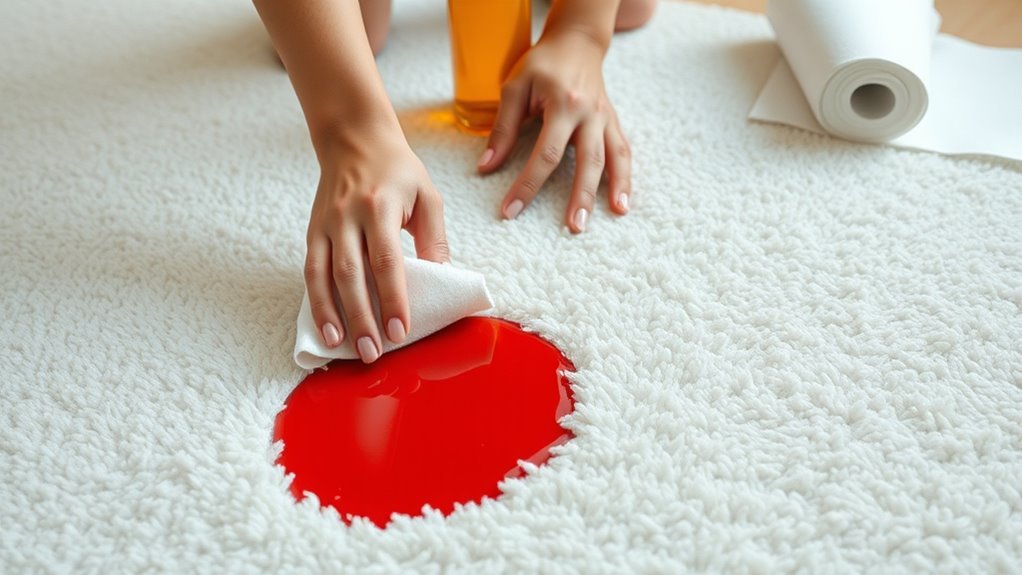
Dealing with liquid spills from your pet requires quick action, and the key is to blot rather than rub. Rubbing can spread the stain and push the liquid deeper into the fabric, making cleanup harder. Using effective blotting techniques helps maximize spill absorption, protecting your floors and furniture. Grab a clean, absorbent cloth or paper towel and gently press on the spill, lifting as much liquid as possible without scrubbing. Immediate cleanup is essential to prevent stains and lingering odors, especially when using effective cleaning solutions.
| Common Spill Types | Recommended Blotting Materials |
|---|---|
| Water-based spills | Microfiber cloth or paper towels |
| Urine or vomit | Disposable absorbent pads |
| Water with dirt | Clean cotton cloth |
Regularly Wash Pet Bedding and Toys
Although it might seem like a simple chore, regularly washing your pet’s bedding and toys is essential for maintaining a clean, healthy environment. Clean bedding materials reduce allergens and odors, while proper toy maintenance prevents bacteria buildup. To keep things fresh and safe, follow these steps:
- Check care labels on bedding materials to choose the right cleaning method.
- Use pet-safe detergents to avoid skin irritations or allergic reactions.
- Wash plush toys frequently, and sanitize hard toys with a mild bleach solution.
- Dry items thoroughly to prevent mold and mildew growth.
Establishing a cleaning schedule can help maintain consistency and ensure your pet’s items remain hygienic over time.
Keep Cleaning Supplies Handy
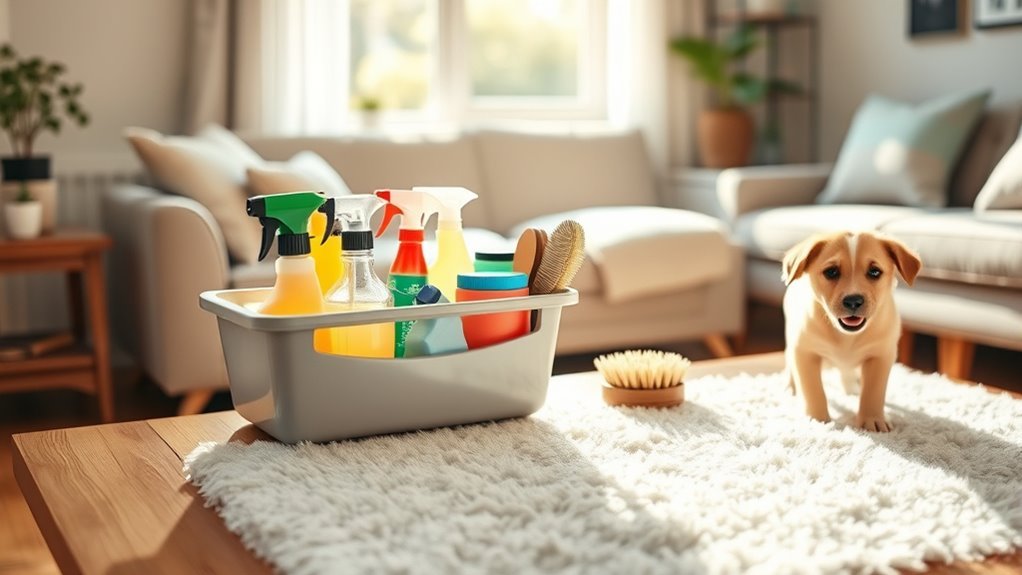
Since pet messes can happen unexpectedly, it’s important to keep your cleaning supplies within easy reach. Having a well-organized system, like cleaning caddies, guarantees you can quickly grab what you need without wasting time searching. A compact cleaning caddy lets you store essentials such as stain removers, disinfectants, paper towels, and gloves all in one place. This supply organization not only saves you effort but also helps maintain a clutter-free environment, giving you more freedom to enjoy your time with your pet. By keeping your supplies handy and neatly arranged, you’re prepared to tackle messes promptly, preventing stains from setting and odors from lingering. This practical approach makes cleanup less stressful and supports a cleaner, healthier living space for you and your furry friend. Storing pet-safe cleaners ensures that your cleaning efforts are both effective and safe for your animals.
Vacuum Frequently to Remove Pet Hair
Along with keeping your cleaning supplies ready, staying on top of pet hair is key to maintaining a clean home. Frequent vacuuming not only controls pet hair buildup but also reduces allergens, giving you more freedom to enjoy your space. To maximize your efforts, consider these vacuuming techniques:
- Choose a vacuum with strong suction and a pet hair attachment.
- Vacuum high-traffic areas and pet resting spots daily.
- Use slow, deliberate strokes to lift embedded hair.
- Empty the vacuum bag or canister regularly to maintain performance.
Regular cleaning of vacuum filters and brushes maintains vacuum performance.
Use Baking Soda to Neutralize Odors
You can effectively neutralize pet odors by sprinkling baking soda on carpets, upholstery, or bedding. Its natural odor-absorbing properties help eliminate smells rather than just masking them. Just let it sit for 15-30 minutes before vacuuming to freshen the area thoroughly. Baking soda is often combined with vinegar in a natural cleaning solution to tackle tougher pet stains.
Odor Absorption Benefits
Although pet messes can leave stubborn odors behind, using baking soda is a simple and effective way to neutralize them. As one of the most popular natural deodorizers, baking soda offers several odor absorption benefits that empower you to maintain a fresh home environment without harsh chemicals. Here’s why it works well in odor removal techniques:
- Baking soda absorbs moisture, which often traps odors, preventing them from lingering.
- It chemically neutralizes acidic and basic odor compounds, balancing unpleasant smells.
- It’s non-toxic and safe for pets and children, providing a worry-free cleaning option.
- Its fine texture allows it to reach deep into carpets, upholstery, and fabrics where odors hide.
Incorporating baking soda into your cleaning routine helps you enjoy a freer, fresher living space effortlessly.
Application Techniques
When dealing with pet odors, knowing how to properly apply baking soda can make all the difference in neutralizing smells effectively. Start by sprinkling a generous layer of baking soda directly onto the affected area. Allow it to sit for at least 15 minutes; for stubborn odors, leave it overnight. Using appropriate cleaning tools like a soft brush or vacuum with a brush attachment enhances the application methods by helping the baking soda penetrate fabrics and carpets deeply. After the waiting period, thoroughly vacuum the area to remove all the powder along with trapped odors. This method not only neutralizes unpleasant smells but also avoids harsh chemicals, giving you a safe, natural solution. With these simple steps, you’ll reclaim freshness and enjoy a freer, cleaner living space.
Clean Litter Boxes Daily
Cleaning your cat’s litter box daily is essential to maintaining a healthy and odor-free environment. Proper litter box maintenance not only keeps your space fresh but also supports your cat’s well-being. Different litter box types may require specific care, but daily cleaning is a universal necessity. Here’s how to stay on top of it:
- Scoop waste promptly to prevent odors and bacterial buildup.
- Dispose of clumps and solids in a sealed bag to contain smells.
- Stir the clean litter to aerate and extend its usability.
- Wipe down the box’s interior weekly to remove residue and prevent stains. Wear gloves during cleaning for protection and ease.
Protect Furniture With Covers
Keeping your cat’s litter box clean helps reduce odors inside your home, but protecting your furniture from pet-related wear and tear is just as important. You can maintain your freedom to relax without worry by using effective furniture protection strategies. Selecting the right cover materials—such as waterproof fabrics, durable slipcovers, or washable throws—can shield your sofas and chairs from fur, scratches, and accidents. These covers are easy to remove and clean, saving you time and effort while preserving your furniture’s appearance. Remember, investing in quality cover materials not only extends the life of your furnishings but also creates a comfortable space where both you and your pet can enjoy without restrictions. Prioritize furniture protection to keep your home fresh and inviting. Using natural cleaning solutions on your furniture covers ensures safety for both your pet and your family.
Train Pets to Minimize Messes
Although pets bring joy to your home, they can also create messes that require patience and consistency to manage. Training your pets to minimize messes not only keeps your space clean but also fosters a harmonious environment. Here’s how to get started:
- Use positive reinforcement consistently to reward good behavior, encouraging your pet to repeat it.
- Establish consistent commands for specific actions like “sit,” “stay,” or “go potty,” so your pet understands expectations clearly.
- Set up a regular routine for feeding, bathroom breaks, and playtime to reduce accidents and restlessness.
- Be patient and persistent; training takes time but leads to lasting freedom for both you and your pet.
- Incorporating designated potty areas can significantly reduce indoor accidents and messes.
Frequently Asked Questions
How Do I Clean Pet Messes From Hardwood Floors?
When cleaning pet messes from hardwood floors, start by gently blotting the area with a soft cloth to avoid spreading. Use a hardwood-safe cleaner to protect your floor’s finish while maintaining hardwood maintenance. Quickly addressing spills helps with mess prevention, preserving your floor’s beauty. Regularly cleaning and using protective mats in pet areas gives you more freedom to enjoy your home without worrying about damage or odors, keeping your space fresh and inviting.
What Are the Safest Cleaning Products for Pets?
When choosing cleaning products, you’ll want to prioritize natural cleaners to keep your pets safe and your home fresh. Avoid harsh chemicals that can irritate their skin or respiratory system. Homemade solutions, like diluted vinegar or baking soda mixed with water, are effective and pet-friendly options. These alternatives let you clean confidently, knowing you’re protecting your furry friends while maintaining a healthy environment for everyone to enjoy.
Can I Use Vinegar to Clean Pet Urine?
You can use vinegar to clean pet urine because of its natural vinegar benefits, like neutralizing urine odor effectively. Vinegar’s acidity breaks down the compounds causing the smell, helping your space feel fresh again. Just mix equal parts white vinegar and water, apply it to the stain, then blot dry. Avoid harsh chemicals, so your pets stay safe and your home stays clean—giving you more freedom to enjoy time together.
How Do I Remove Pet Stains From Carpets Permanently?
Oh sure, just wave a magic wand and *poof*—pet stains vanish forever! In reality, permanent removal takes smart stain removal techniques. Start by blotting, not rubbing, then apply a carpet cleaning solution designed for pet stains. Enzymatic cleaners break down odors and stains at their source, giving you freedom from repeat messes. Remember, patience and prompt action are your best allies in reclaiming your carpet’s fresh look.
What’S the Best Way to Clean Pet Hair From Clothing?
To clean pet hair from clothing effectively, you’ll want to start with lint rollers—they’re quick and catch hair easily. Before washing, try using fabric softeners; they help loosen pet hair from fibers, making it easier to remove. You can also toss clothes in the dryer with a dryer sheet for a few minutes to loosen hair before laundering. These simple steps give you freedom from pet hair without much hassle.
